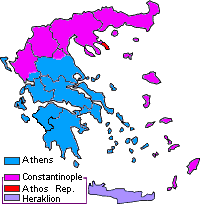Tomos dated 29 June 1850

The tomos dated 29 June 1850 is the official decree of the Ecumenical Patriarchate which gave de jure autocephaly to the then-de facto autocephalous Church of Greece.
History[]
Declaration of autocephaly by Greece[]
The decision to create an independent Kingdom of Greece from the Three Great Powers (the British Empire, the Russian Empire and the Kingdom of France), finalized by the Treaty of Constantinople (1832), posed a dilemma for Greek patriarchal and religious society: whether there is an independent Church of Greece or in the independent state extends the ecclesiastical jurisdiction of the Ecumenical Patriarchate of Constantinople.[1]
The government declared the Church of Greece to be autocephalous in 1833 in a political decision of the Bavarian regents acting for King Otto, who was a minor. The decision roiled Greek politics for decades as royal authorities took increasing control.
Signing of the tomos[]
In the end, the Ecumenical Patriarchate of Constantinople decided on a compromise: the Ecumenical Patriarchate agreed to give autocephaly to the Church of Greece through a tomos which was dated 29 June 1850.
Aftermath[]
The decision of the Ecumenical Patriarchate to give autocephaly to the Church of Greece catalyzed the Bulgarian National Revival and ultimately led to the Bulgarian schism after which ethnophyletism was condemned.
The tomos dated 29 June 1850 was fastened by a royal decree of 15 August 1850, after which Law No. 201 of 9 July 1852 was adopted, called the Statute for the Holy Synod of the Greek Church. Two laws (200 and 201) were inspired by state churches in Protestant countries, in which the monarch is the formal head of the church. Consequently, the Statute decrees that the King is the head of the Greek Church. Its supreme authority was the Synod appointed by the King.[2] A royal plenipotentiary wielded veto powers on behalf of the monarch. Between 1860 and 1923, the church was subject to royal and national politics.[3]
Mount Athos, Crete, Macedonia, Thrace, and the eastern Aegean Islands remained under the Ecumenical Patriarchate.
See also[]
References[]
- ^ ΠΑΤΡΙΑΡΧΙΚΟΣ ΚΑΙ ΣΥΝΟΔΙΚΟΣ ΤΟΜΟΣ
- ^ Nikolaos-Nikodemos Anagnostopoulos, The development of the Ecclesiology and the Political Theology of the Ecumenical Patriarchate of Constantinople and the Autocephalous Greek Orthodox Church in response to Muslim Christian relations in the contemporary context of modern Greece and Turkey until 2014, PhD thesis, Heythrop College, University of London, 2015, p. 106.
- ^ Beginning of the History of the Greek Church in the 19th Century (in Bulgarian)
- Christian law
- Ecumenical Patriarchate of Constantinople
- Church of Greece
- Bulgarian National Revival
- Greek nationalism
- 1850 in Christianity